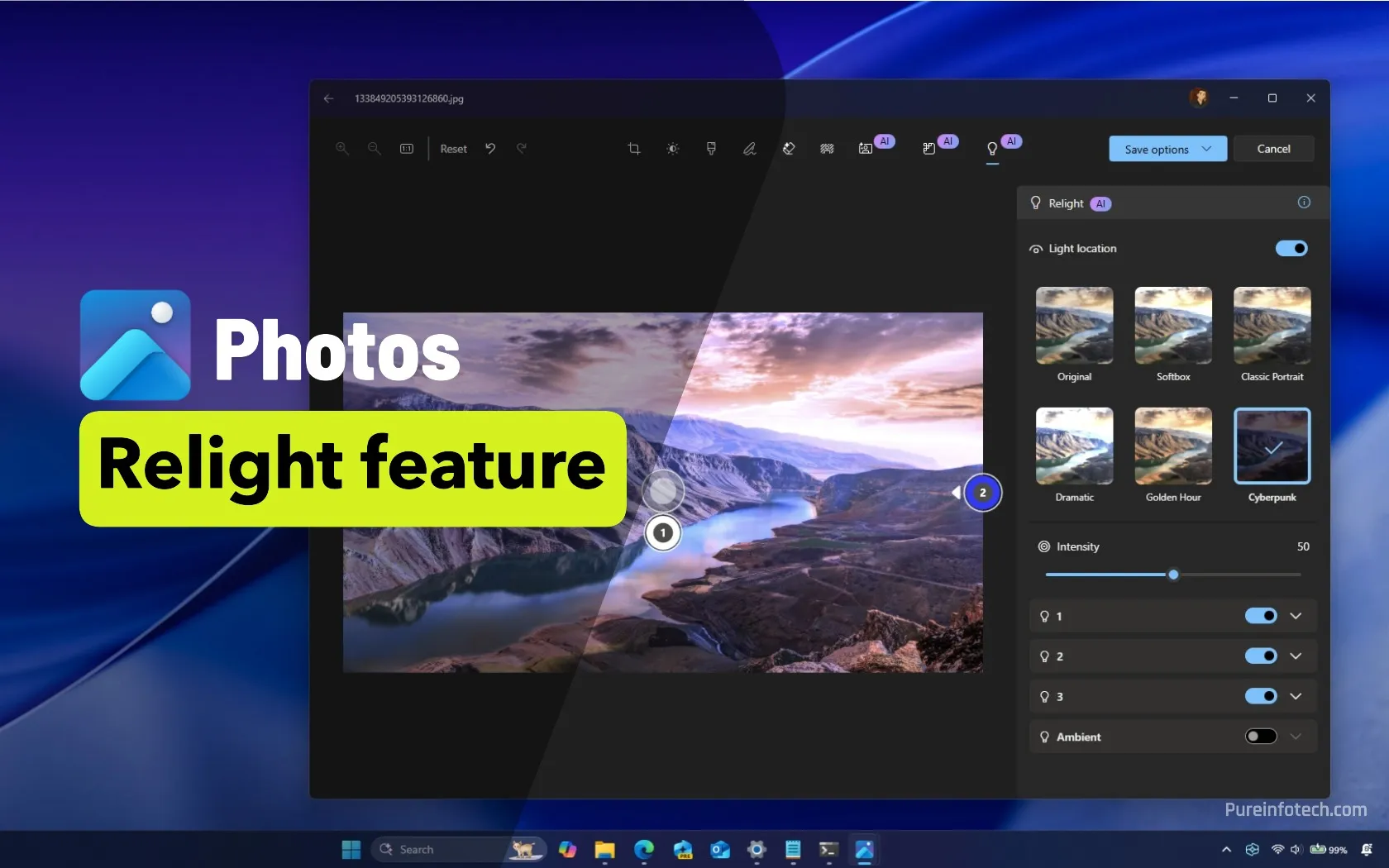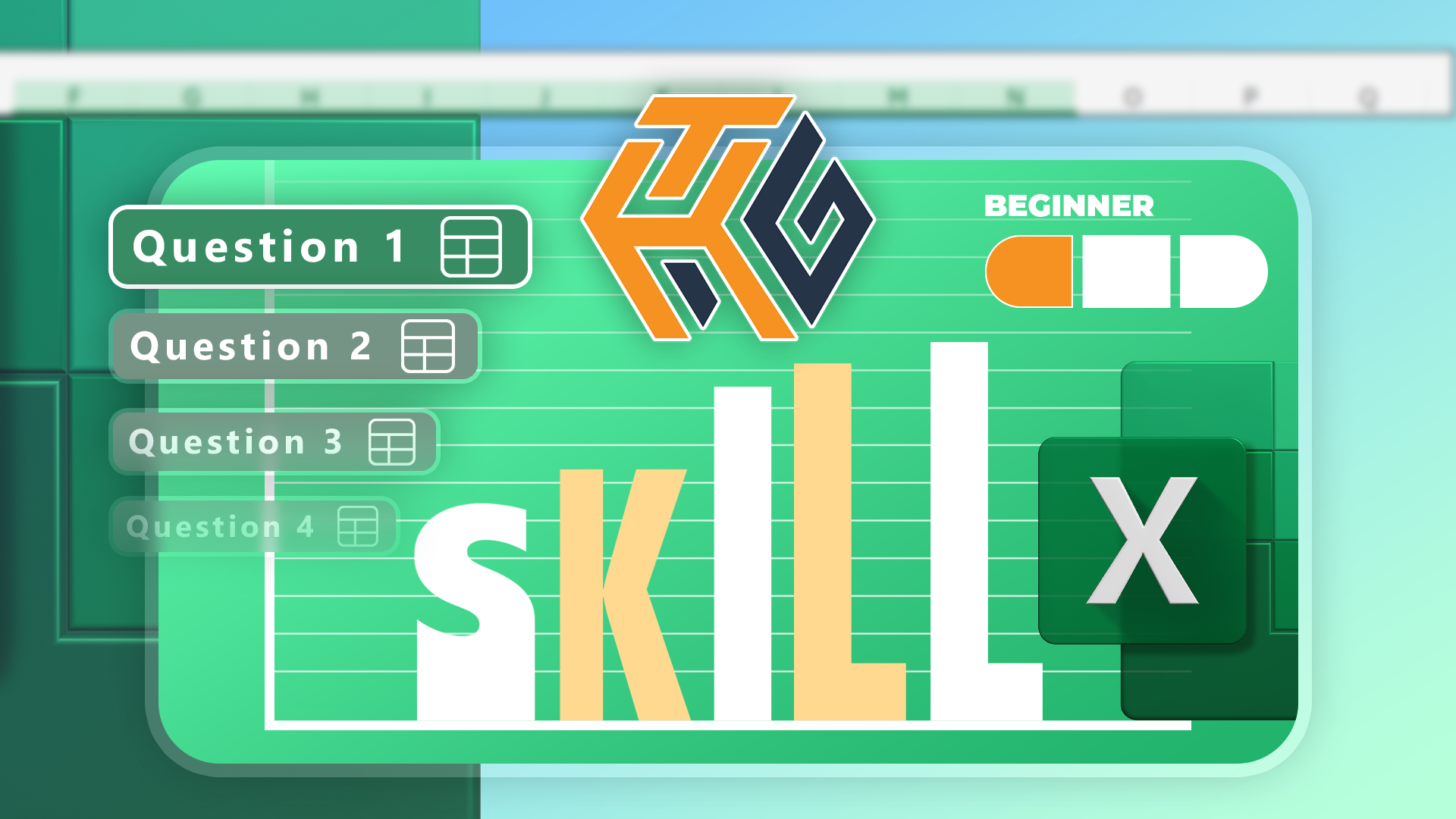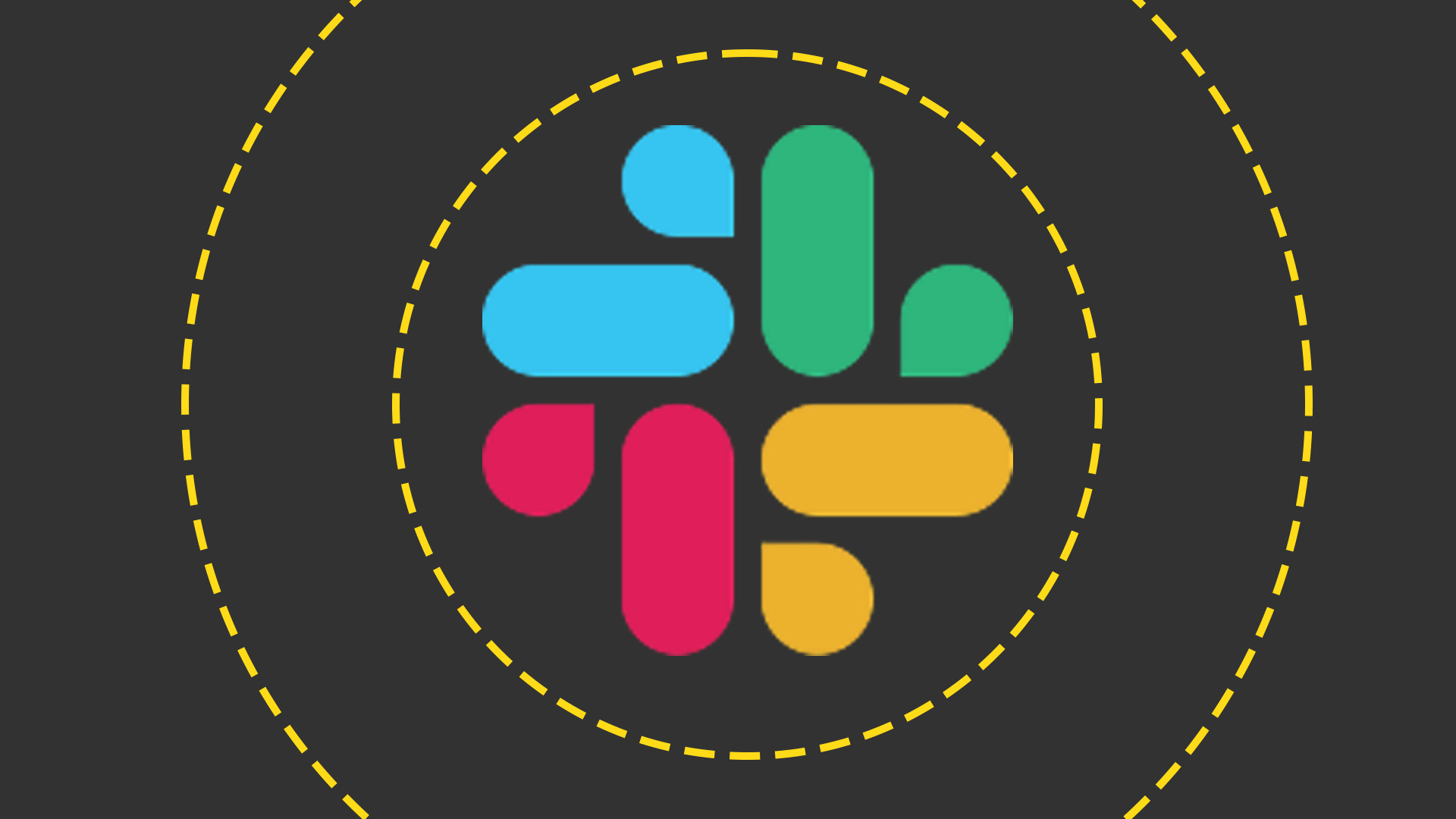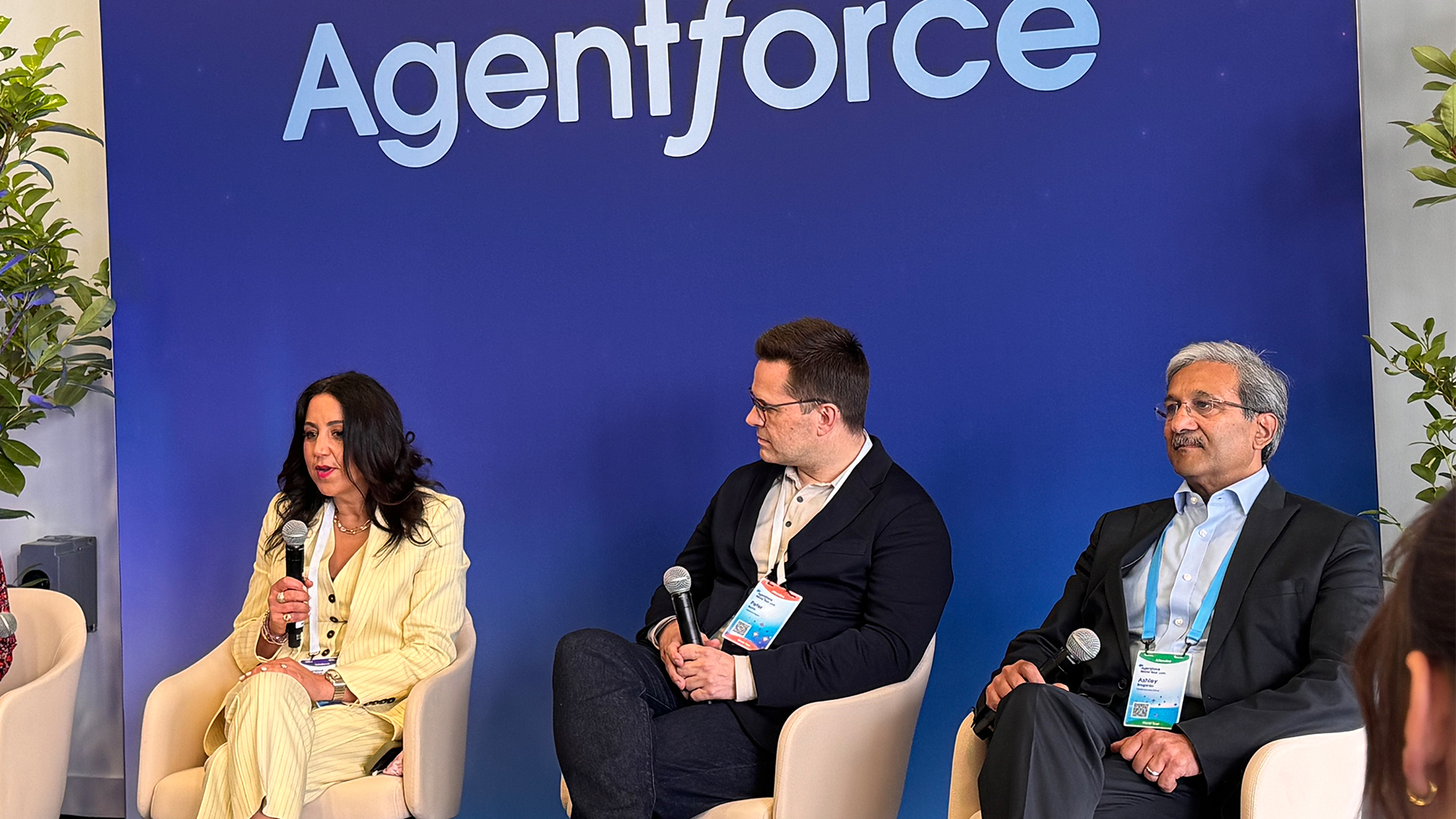Dell Technologies World 2025 live updates and news
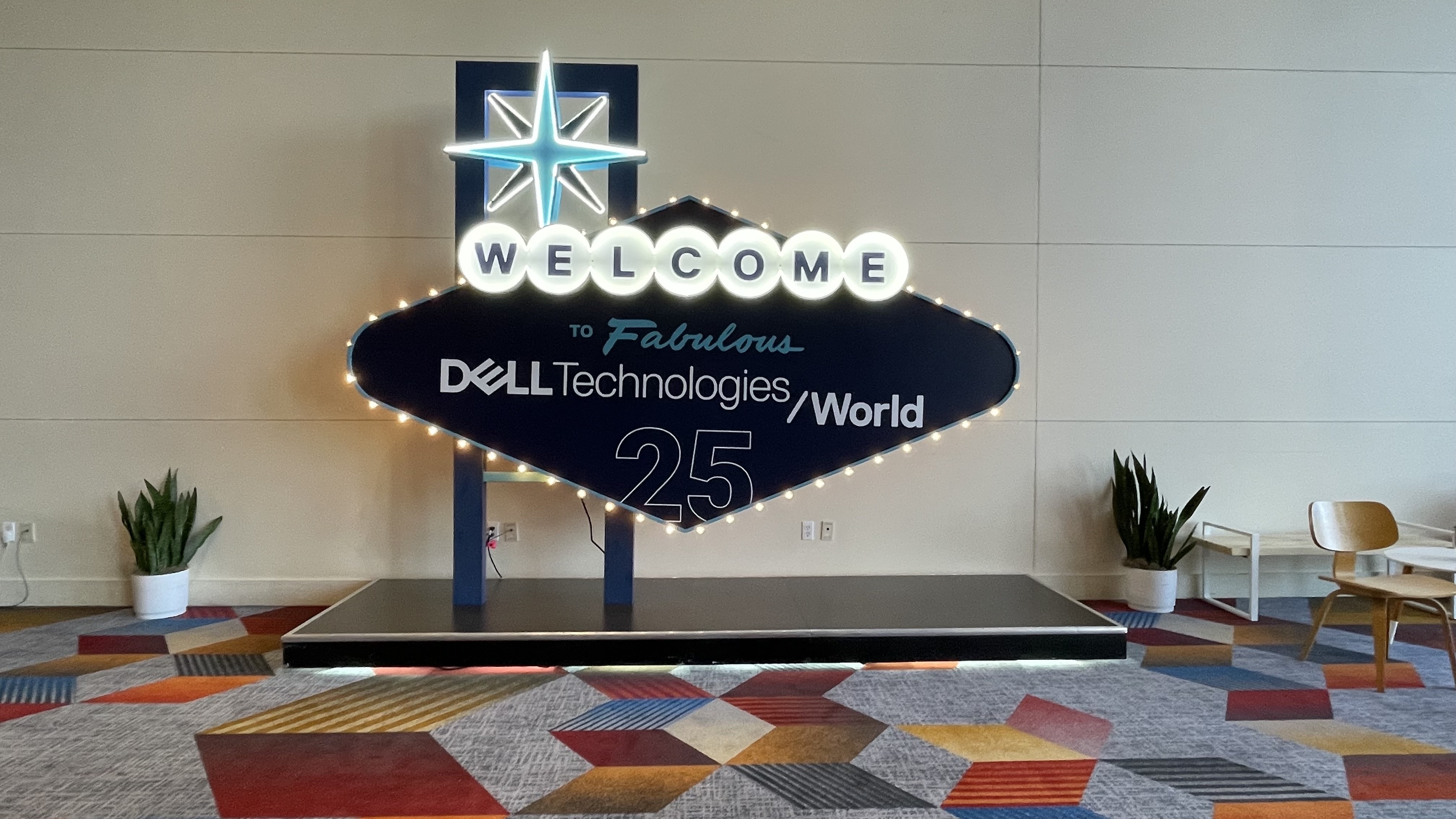
Refresh
That’s the end of the keynote, but not the show. You can read all our coverage so far here, and stay tuned for more news and analysis throughout the rest of the week.
“Dell technology, understands the needs of enterprises, better than. anyone else in our marketplace. We have the right solutions, we have disaggregated architecture with the strongesst ecosystem of partners that you’ve seen today,” he says.
“We’re here to help accelerate you on your journey. Enjoy the show!” And with that, Clarke leaves the stage.
Clarke is back on stage to wrap up.
“AI is taking off like a rocket ship. We’ve innovated at an unmatched pace,” he says. “Our Dell AI factories … we’re in the early innings of enterprise AI. I hope I made it clear, if you don’t start now. You will be behind your competitors.”
That’s not the only hardware on show today, though. Burd also introduces the Dell Pro Max Plus laptop – announced yesterday – once again to applause from the audience. It’s an AI laptop that’s capable of doing inferencing on device. You can read more details about the Dell Pro Max Plus here.
(Image credit: Jane McCallion/Future)
Announced at GTC, it’s capable of one petaflop of calculations per second, which Burd says is “great for an AI developer to get going with their own dedicated desk side AI resources, or my favorite, stack and couple together and you’ve got a mighty edge inference machine”.
Applause, whoops and cheers from the audience – they love it apparently, and Burd says he does too.
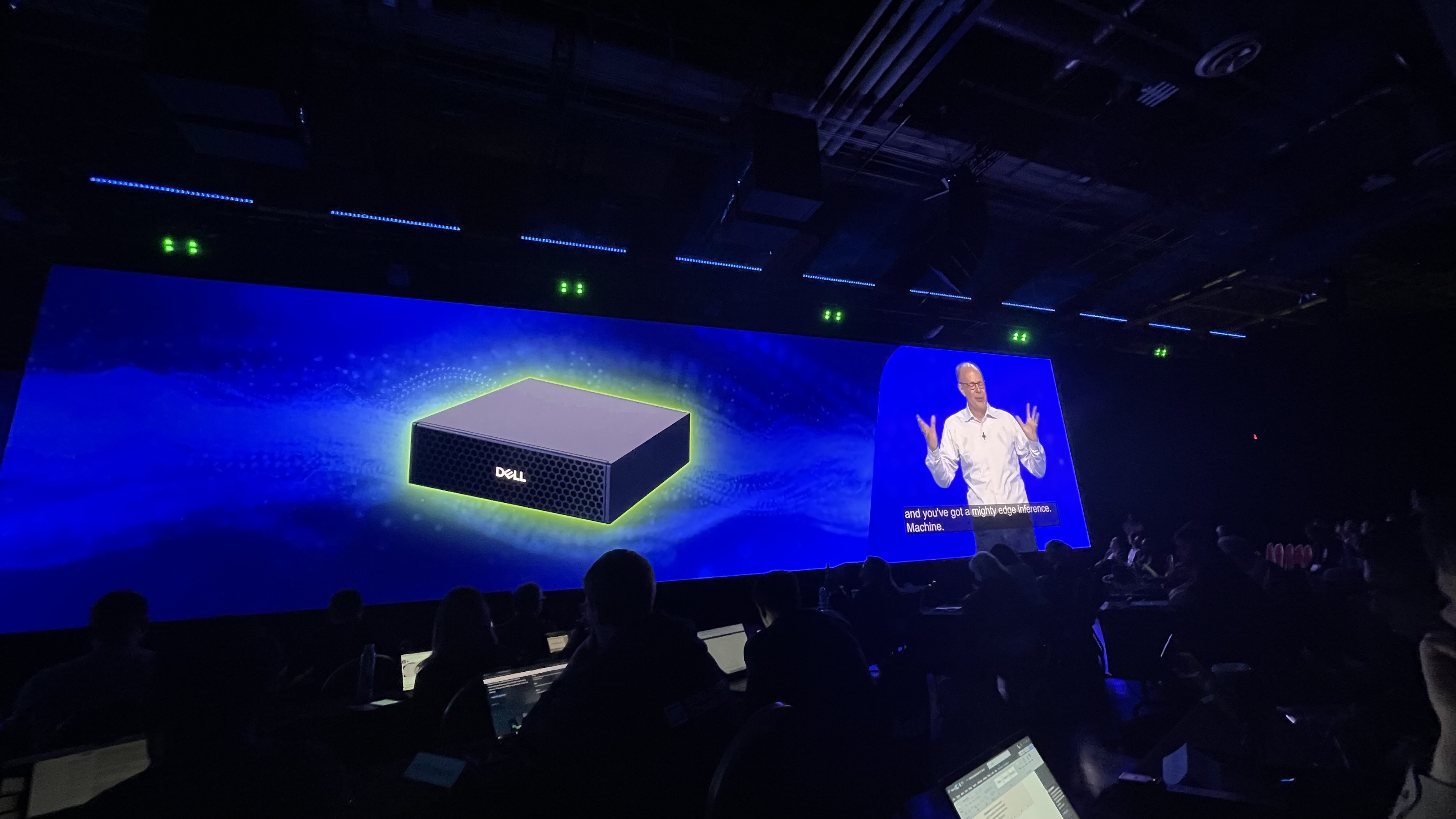
(Image credit: Future)
And here’s one he (or, rather, Dell) made earlier: Burd holds up a Dell Pro Max with GB10. This can best be described as an AI mini PC. It really is very small, but as the company says has some pretty impressive specs.
Burd’s impressing upon the audience the importance of the edge for AI and that, for most enterprises, the PC is “the ultimate edge device”.
“Fast forward to 2030, for a few years beyond that, there will be 2 billion AI PCs, each capable of hundreds or 1000s of tops Jeff’s token machines made personal.”
“I can tell you that AI revolution is not a spectator sport, and with Dell Technologies, you’re not just ready for the future. We are. You are defining it,” Burd tells delegates.
Next speaker: Sam Burd, president of the client solutions group at Dell Technologies
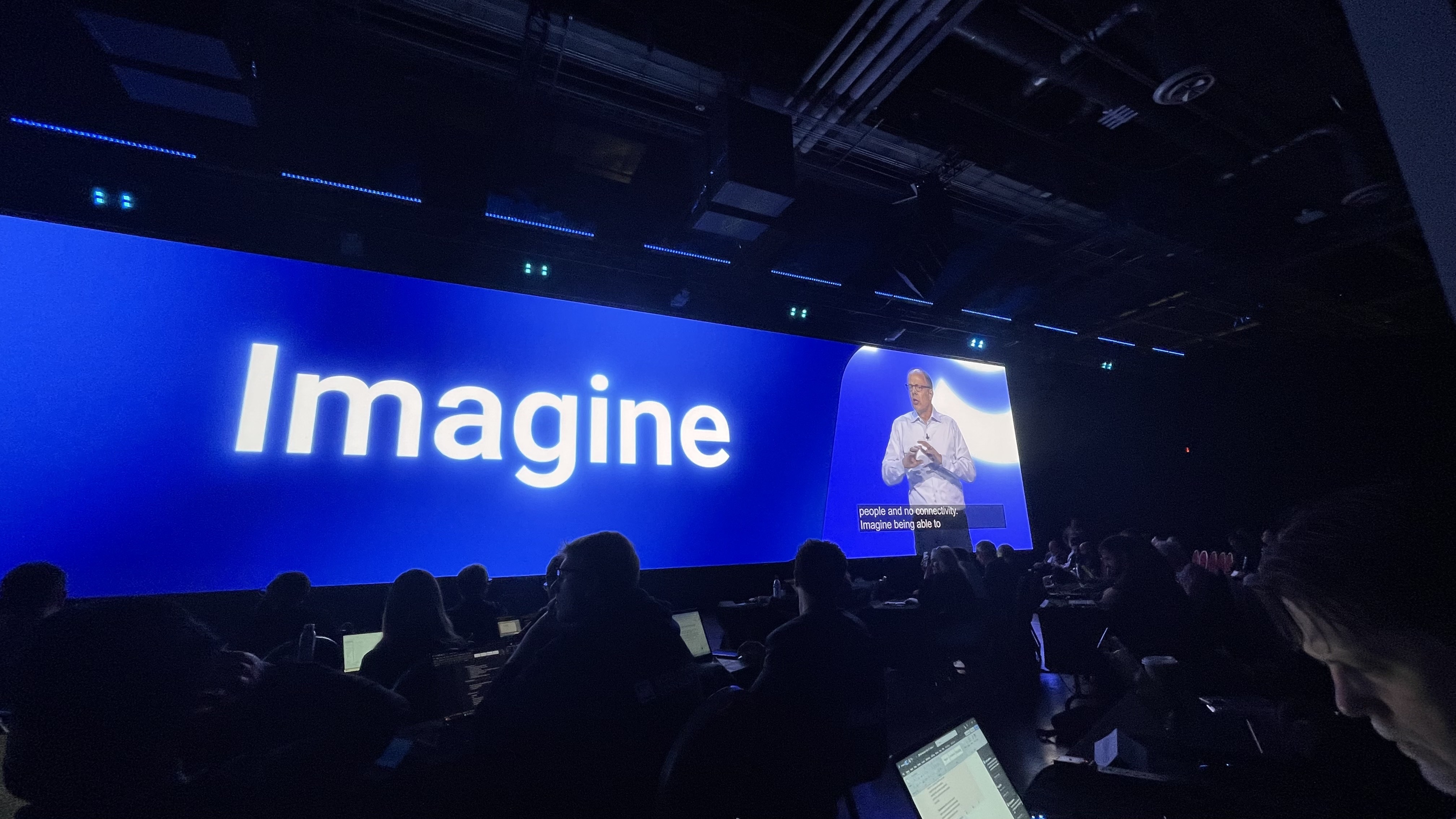
(Image credit: Future)
Gomez leaves the stage and Lewis is now onto the big announcements of the day – significant updates to cybersecurity features on PowerStore, PowerScale and Data Domain.
“The partnership between Dell and cohere marks a significant step forward enterprise. AI, you know, from agentic workloads to seamless integration and robust security. We’re delivering a solution that enhances innovation without increasing complexity.”
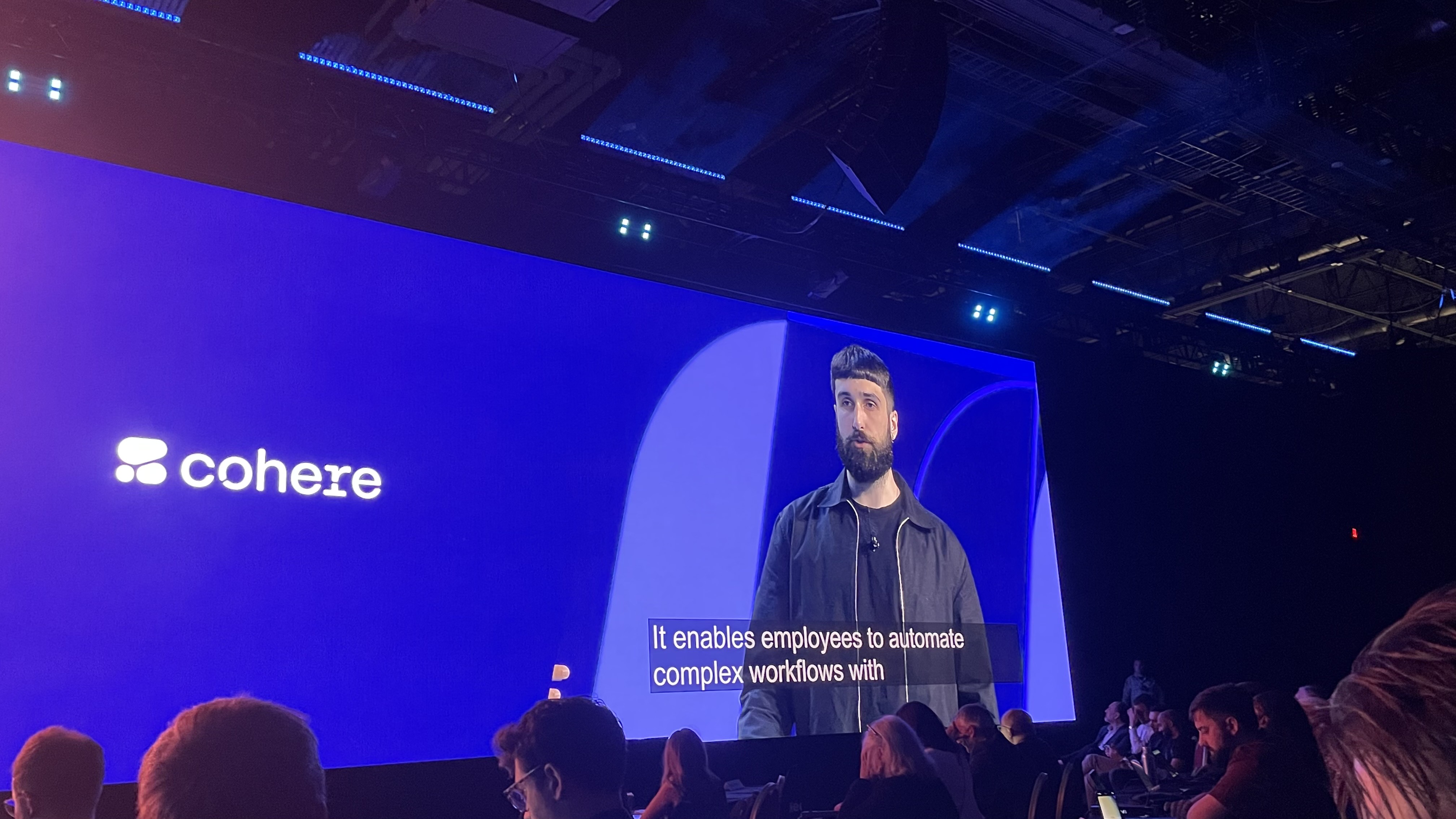
(Image credit: Future)
Aidan Gomez, co-founder and CEO of Cohere, is now on stage to talk about the two companies’ partnership. Focusing on Cohere North, its “secure AI agents platform.
“It enables employees to automate complex workflows with seamless data integration, comprehensive security features,” Gomez says.
He’s also talking up the new partners on Dell AI Factory, including AMD, Intel, Hugging Face and others. you can read full details on that here.
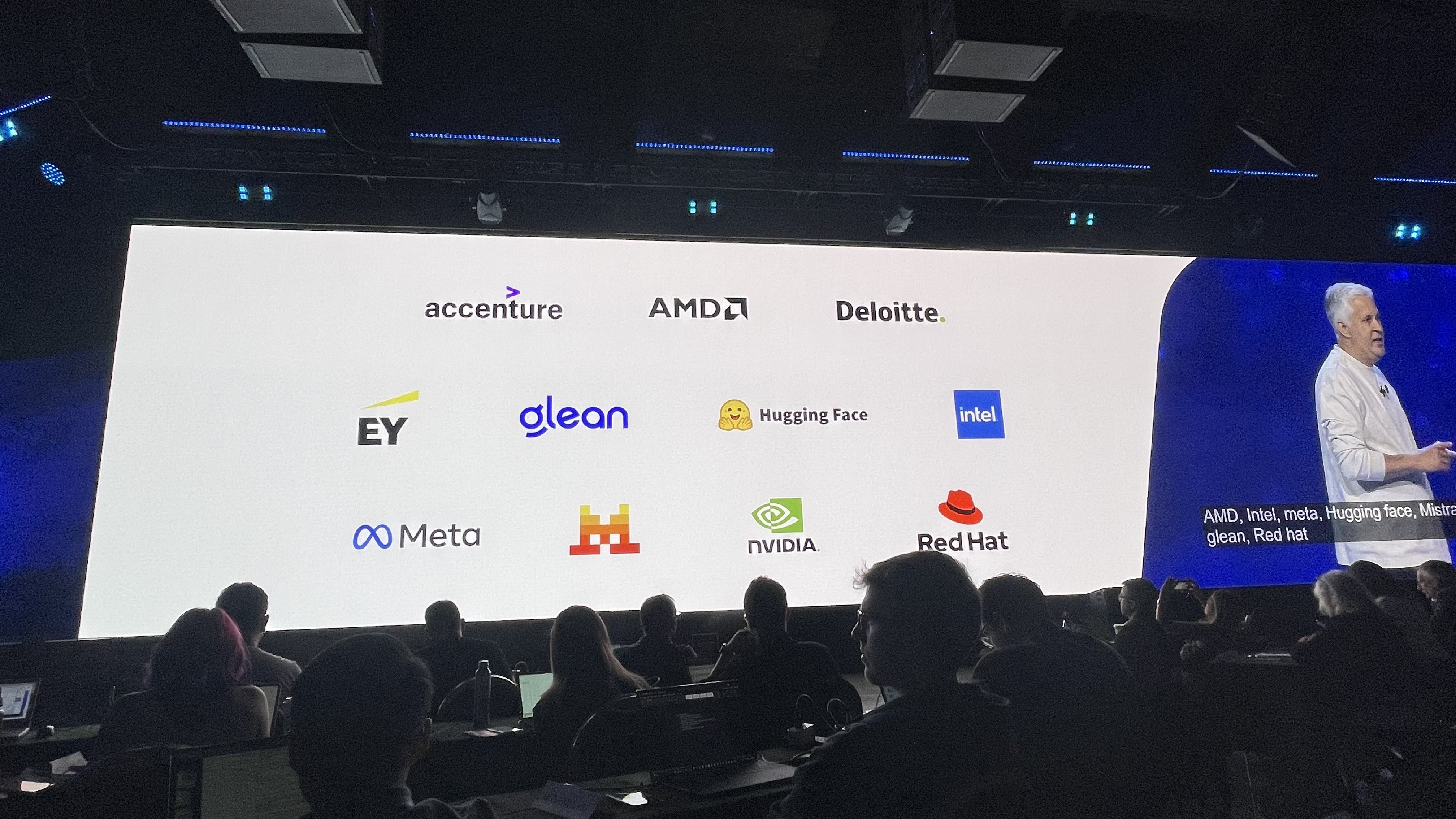
(Image credit: Future)
Lewis is talking up some of the capabilities of Dell Technologies hardware, including PowerScale and ObjectScale.
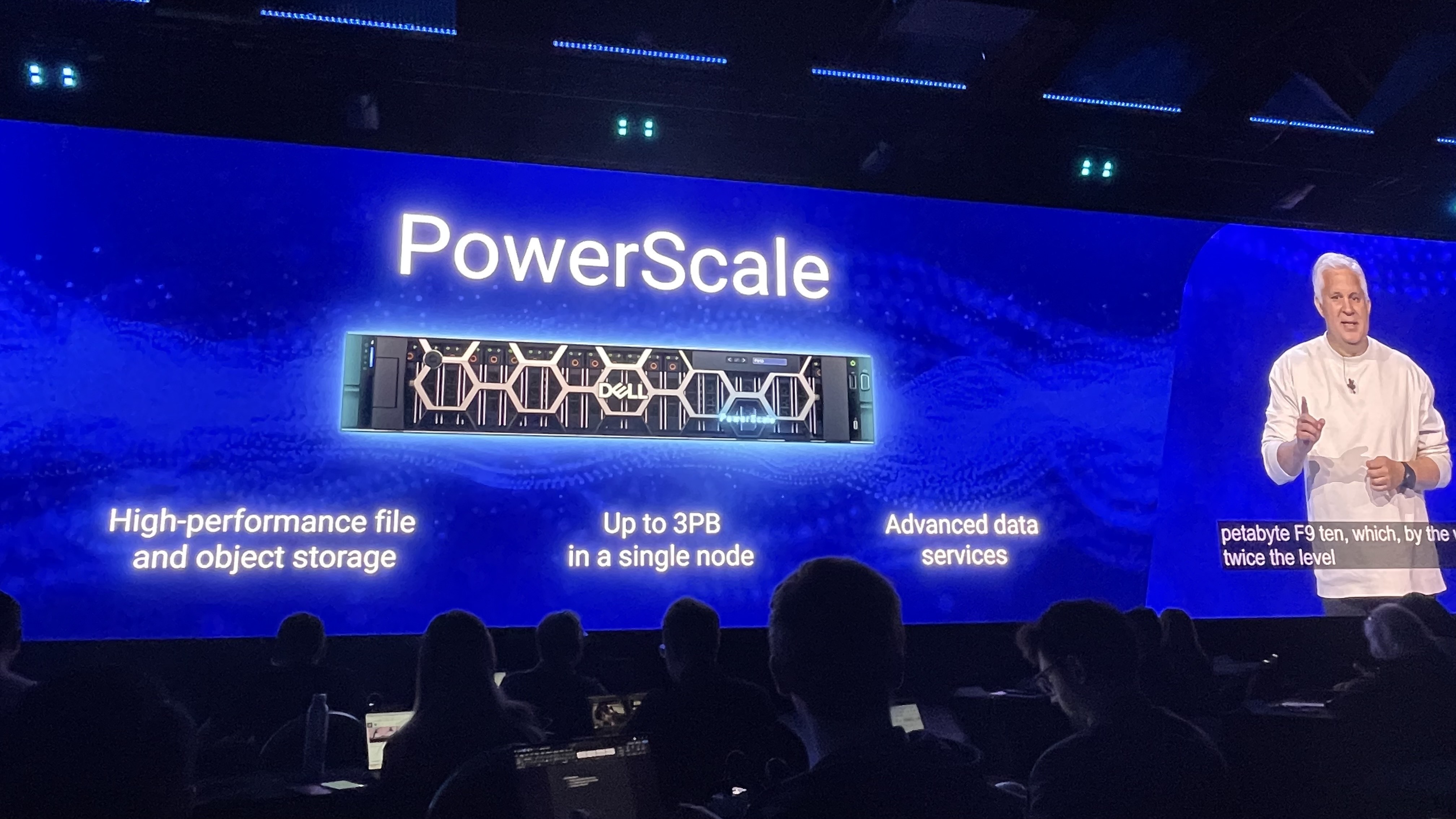
(Image credit: Future)
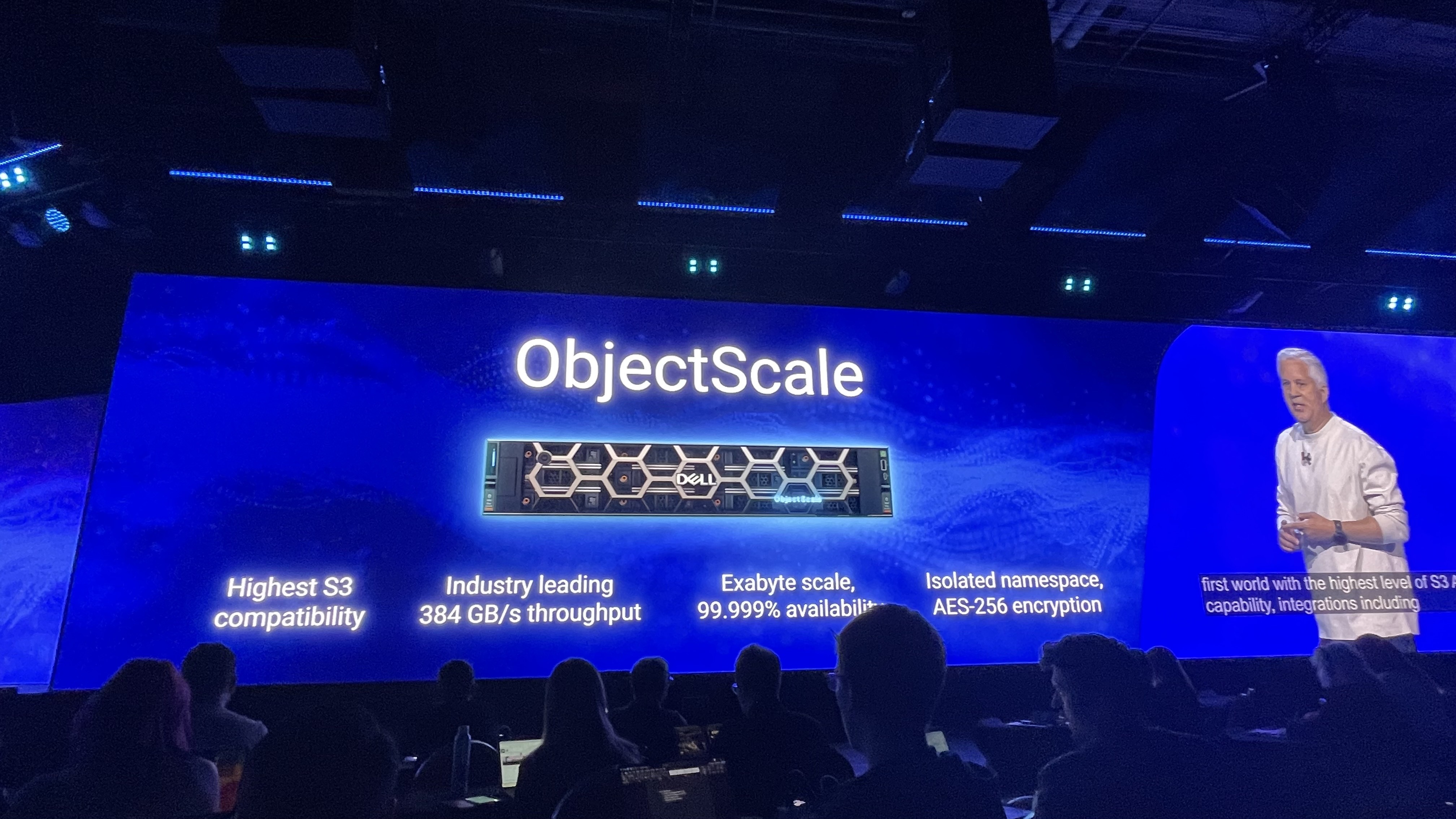
(Image credit: Future)
“I hope we’ve seen that adult technologies we are not simply witnessing the next wave of innovation. We are engineering it. We are not simply building AI tools. We are redefining the future architecture of an intelligent enterprise. Our AI platforms and solutions are private cloud platforms, and our full stack innovation is designed to turn data into intelligence and complexity into clarity, we are empowering customers to deploy AI where it makes sense to modernize without compromise and to innovate at scale with confidence,” he says
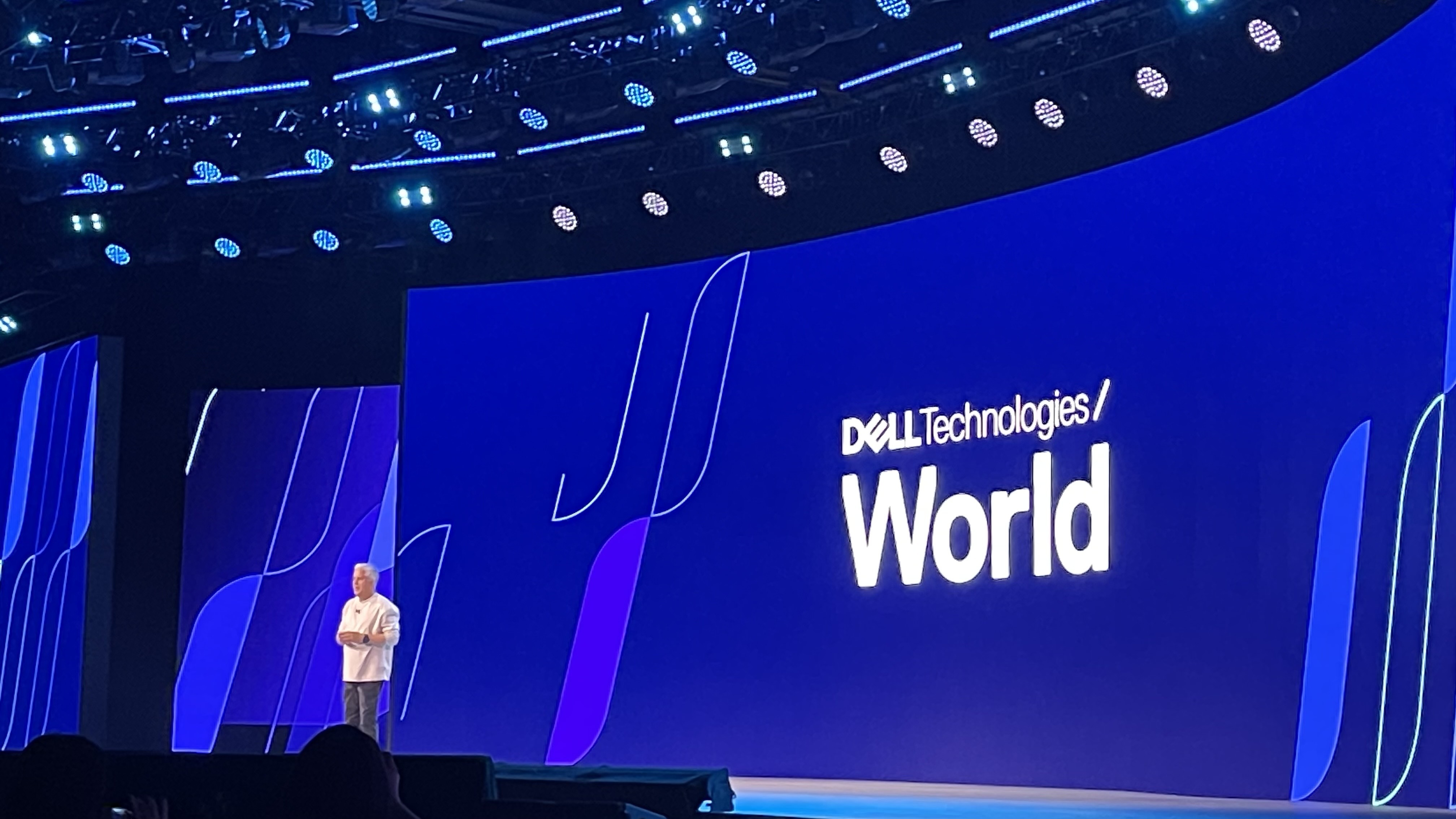
(Image credit: Jane McCallion/Future)
Out next speaker is on the stage, Arthur Lewis, president of the infrastructure solutions group at Dell Technologies.
Agentic AI is very compute heavy, says Clarke.
“They require a world class AI infrastructure, the Dell AI factory with Nvidia as an example, to process what will likely be yet another multiple of tokens in the order of 100 times. So reasoning 100 times tokens 100 times. That’s 10,000 times more processing capability than we would have thought a year ago. That’s the future.”
With that Venturo is gone, and we’re now moving onto the possibilities of agentic AI.
Venturo says there will be no “killer app” for generative AI.
“There’s going to be a subtle impact to everyone’s lives. To make a decision … to make it easier to do things, to make your kids schedules easier, to manage deal with your shopping cart better when you’re ordering information car, like, there’s going to be so many ways that AI impacts us,” he says.
“I think it’s going to happen very, very quietly, and it’s going to be a lot more nuanced than the world expects today. I think that the scale challenge is real,” he says. “To serve all these applications and everybody in this room, you need a lot of GPUs. And the market and the world has to understand that we have to invest in the infrastructure and the critical it to do so.”
“Dell has been incredible, from a speed, you know, a partnership perspective around engineering, your engineering teams world class, better than everybody else we’ve worked with. You solve problems, you proactively solve problems, and you really work with us when we need the most,” he says.
“arly on, our entire goal was, how do we get the scale? How do we have as many GPUs as we can? We’ll figure it out after,” he says.
“When we took our first customer, we were a crypto Mining Company, which is great, because you never had to talk to customers,” Venturo says to laughter from the audience.
“Nobody yelled at you, made money or you did it. And the day that we took on our first customer, we became a business. “
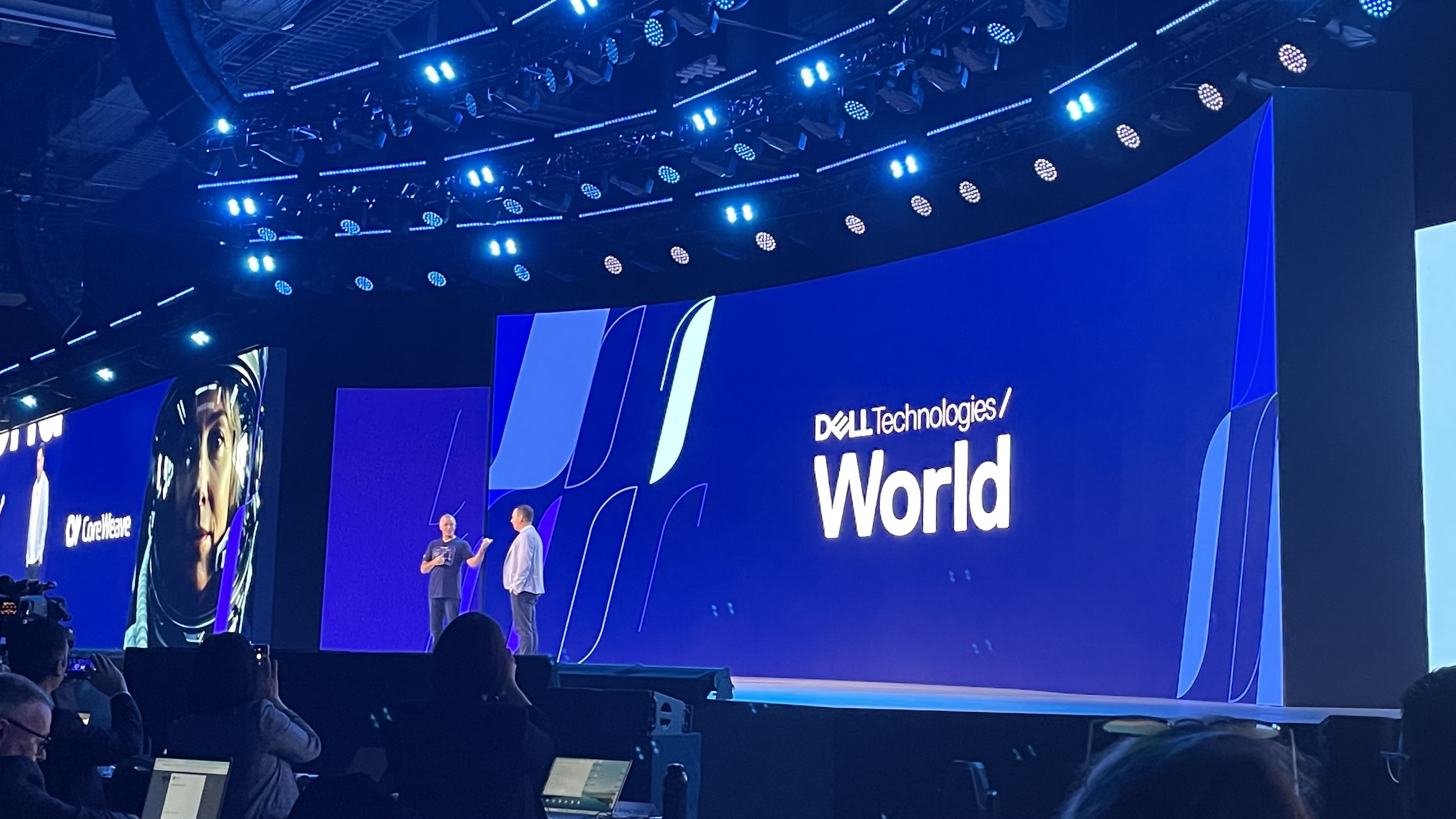
(Image credit: Future)
Venturo is talking about how the company started as a hobby.
“We were building GPU mining rigs in my grandmother’s garage,” he says – an activity that confused his grandfather.
We now have the co-founder and chief strategy officer at CoreWeave on stage Brian Venturo, to give some more color and insight on what Clarke describes as “Big AI”.
He says that as a result, agents close more cases and they do it faster.
“Our dispatch rates are down, our repeat dispatch data, our respect, our repeat our repeat dispatch data are down even more. Our rates are down more and then, most importantly, the thing that matters most is customer satisfaction time.
“So we’re able to solve more cases faster with a higher resolution rate, whether it’s the first time in the second time that a route dispatching, our close rates were down, and the ultimate outcome is a more happy customer.”
“Nothing here is going to be new and unique to you, but for us, it was our first effort at taking what we’ve been talking about now for the better part of two years, a series of AI techniques with open source software like machine and deep learning and, of course, generative AI, we had a combination of variety of prompt engineering very capable large language models,” he says.
“Every one of our service team members now has a genius on their shoulder telling the best way to solve any issue that they have when they’re on the phone. So we created service assistance for all of our service members in our organization.”
Clarke gives an example of how this is working in practice via its global services organization. It used the data that it already has in this department, which is a lot – there are 10s of thousands of reams in over 170 countries with 250 million assets in the field to draw on.
This was largely in silos, however – or “data islands” as Clarke calls them. So they created a “data mesh” to pull it all together and applied generative AI to extract value from it.
So what did they do? First, they put in place some governance and rules, focused on data – where it lives, how it’s used etc. Then the chief AI officer, John Roese, led the charge in deciding how the company would go forward with AI programs and projects.
When they first started, they were “horrified” and “shocked” to discover there were over 900 products branded as AI that the leadership had no idea about.
“We were all over the place” he says.
“Data Governance wasn’t as tight as we wanted it to be, or should have been. We were confused and often interchanged bots and automation Gen AI, confusing ourselves. We were doing that, we lacked strategy architecture.
“In other words, we had a bunch of well intended people working on the latest and coolest technology, and if they called it that, they got funding.”
Clarke has moved on to talking about the challenges companies face when implementing generative AI. Is there really a return? How is it done? Do they have the space, power and tools?
“In the spirit of misery loves company, I thought I’d share the detailed experience we’ve had in this journey over the past two years,” he says.
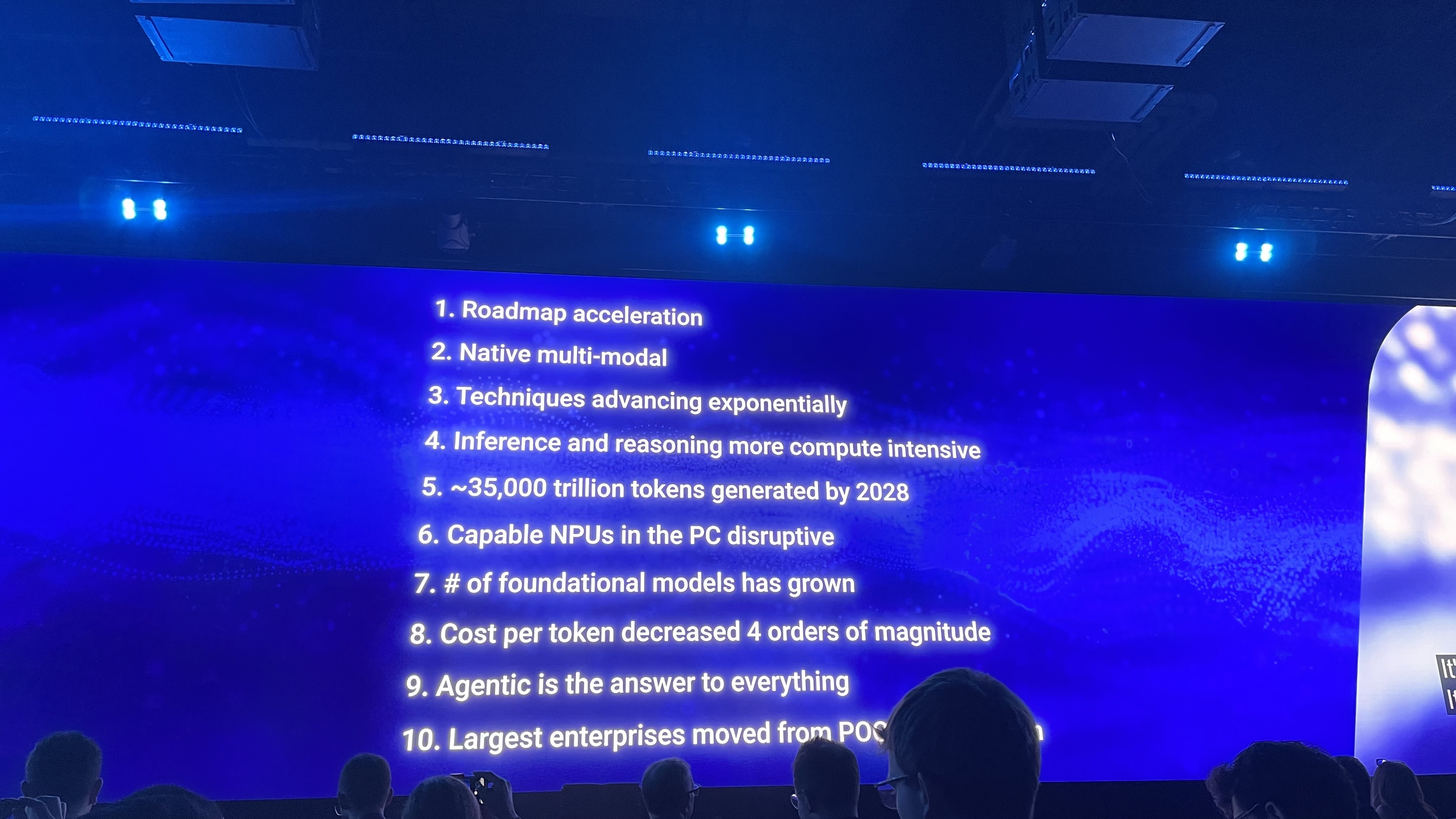
Here is that top 10 list from Clarke
(Image credit: Jane McCallion/Future)
“In the past year, from PCs to the data center to the largest cluster, note the build out edgely network and what’s happening at the edge at scale implementation, but optimize storage, optimized networking, the services around that put together a set of capabilities that, again, has unmatched our industry, and we’ve only continued to build on that” he says.
“I love a good top 10 list, so I’m gonna start our morning off [with one].”
Now we’re talking about Dell’s AI factories. Announced last year, they’ve grown massively, as this graphic shows.
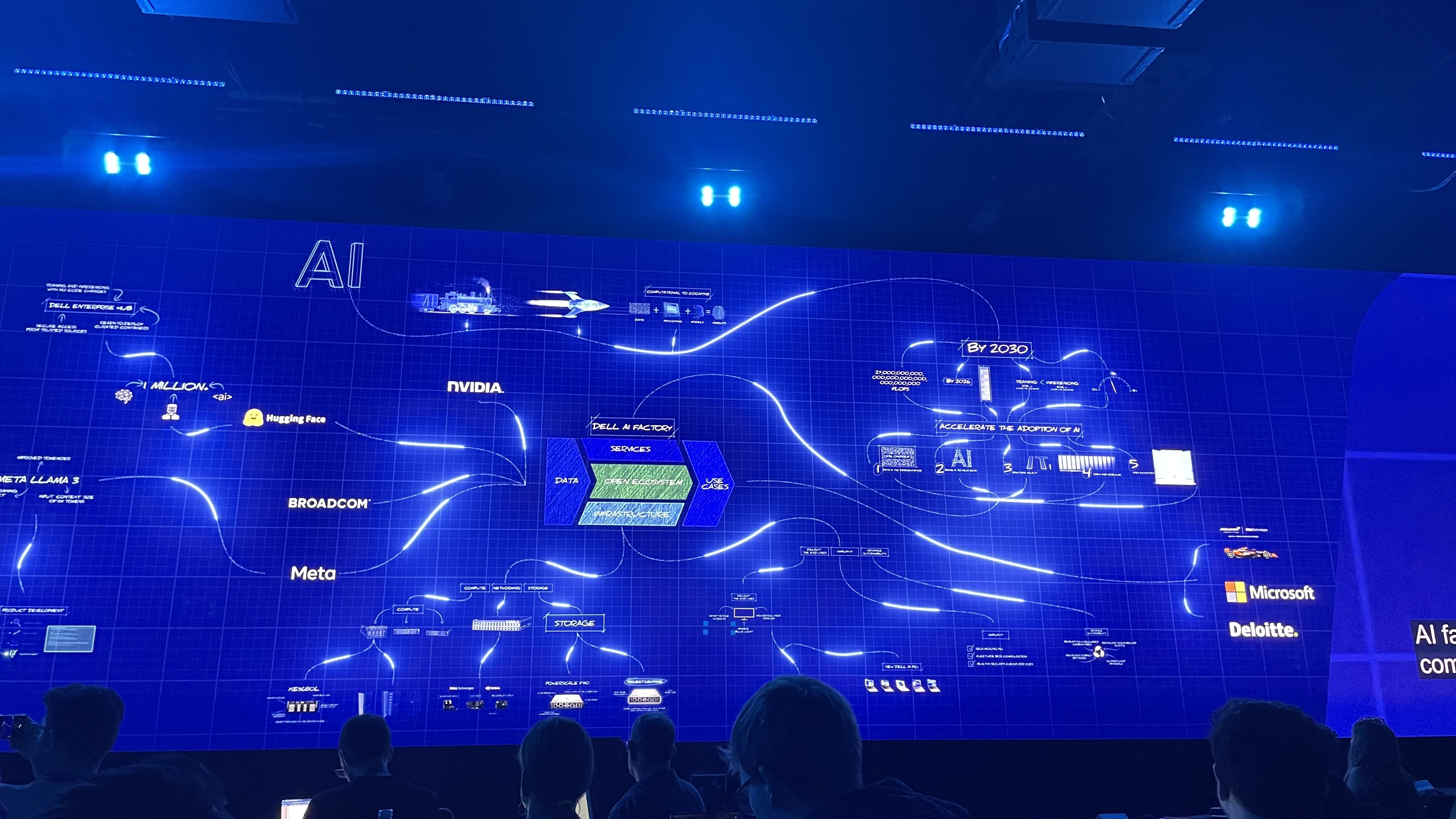
(Image credit: Future)
Jeff is giving an outline of what we’re expecting today, including updates on what was announced last year.
He’s talking about the acceleration of generative AI update, and how expected CapEx will exceed what it took to send Neil Armstrong and Buzz aldrin to the moon – even adjusting for inflation.
Lights, camera, action – here comes Jeff Clarke
What can we expect this morning? Well yesterday Michael Dell said we’d hear more about the Modern Data Center announcements, such as the appliances featured below. There may be some additional announcements today on this topic, although there’s equally plenty to talk about based on yesterday’s news.
Given we also have a representative from CoreWeave on the schedule, generative AI discussion is also firmly on the table, as well as some examples of how Dell’s customers are using its technology. Only five minutes to go…
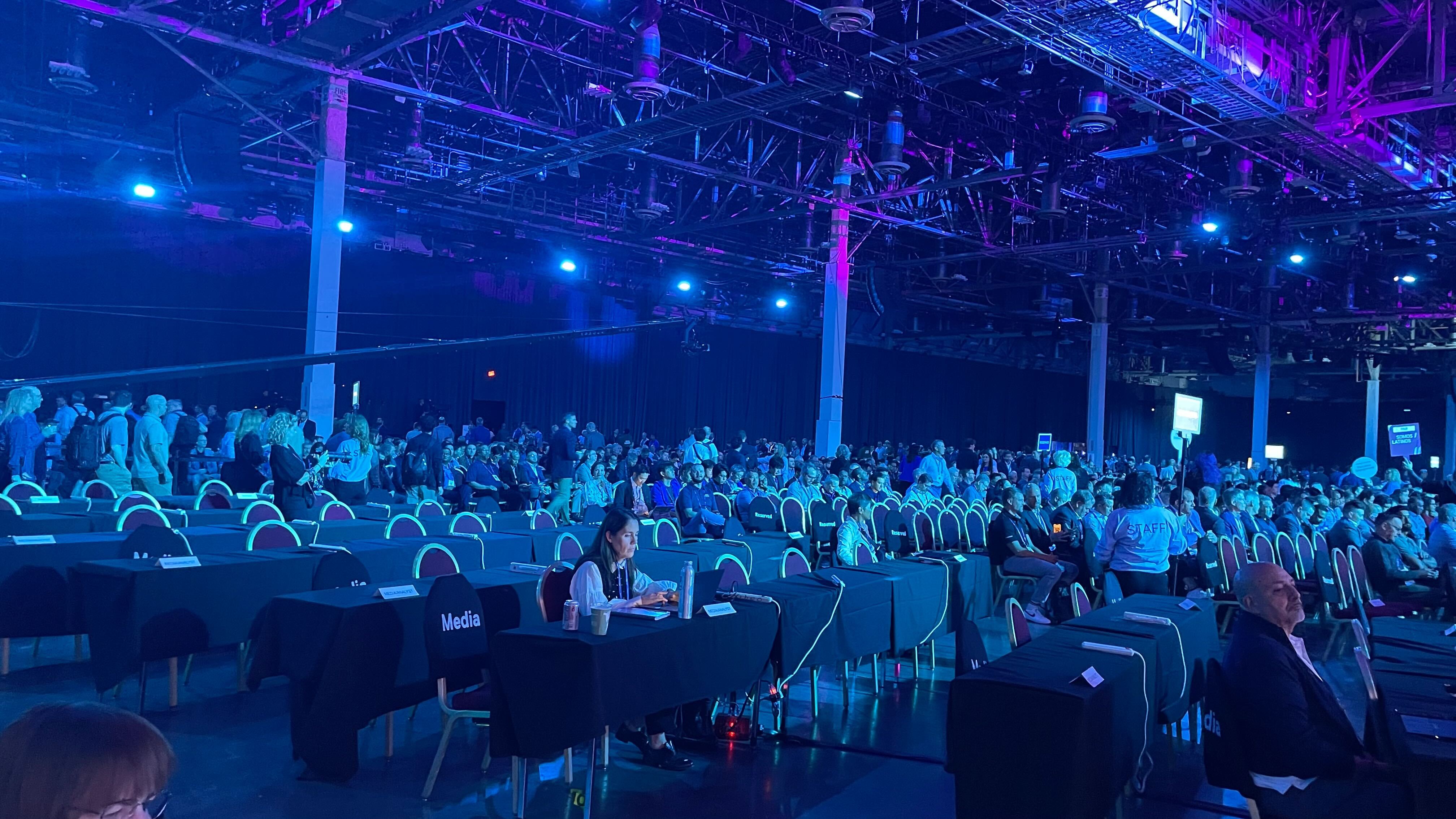
(Image credit: Jane McCallion/Future)
The main theater is open and seats are starting to fill up with delegates ahead of the day two keynote with COO Jeff Clarke.
We’ve got a steady stream of delegates making their way through the Palazzo towards breakfast at the Venetian conference & expo center ahead of today’s keynote. Once again a real buzz about the place as we approach the opening session.
While we had two customer speakers yesterday, from JPMorgan Chase and Lowe’s, Jensen Huang, CEO of Nvidia, wasn’t there in the flesh, with a video of him and Michael Dell discussing Dell Technologies AI Factory With Nvidia 2.0 run instead.
ITPro understands Huang was supposed to attend but travel problems meant he wasn’t able to get back from Computex in time. Let’s hope the same fate hasn’t befallen any of today’s speakers, who are:
- Brian Venturo, co-founder and Chief Strategy Officer of CoreWeave
- Arthur Lewis, president of the infrastructure solutions group at Dell Technologies
- Aidan Gomez, co-founder and CEO of Cohere
- Sam Burd, president of the client solutions group at Dell Technologies
- Rob Johnson, executive director of workforce digital services at USAA
Welcome to day two of Dell Technologies world here in Las Vegas Nevada. To recap yesterday’s keynote from CEO, chairman and founder, Michael Dell, took a strategic tone with a focus on AI, data, and how they’re being used. While the company did make some product announcements, the keynote was light on detail, although we were told there would be more information on some of the new “modern data center” products in today’s keynote.
We’re now onto the “final stop of Dell Technologies Way”, to talk about practical, everyday uses of AI with a video from a startup that creates a robot called Norby that helps people learn new languages and with speech therapy.
Final thought – “Ai is the new electircity and Dell is the grid powering the transformation, connecting the data, the intelligence and the innovation,” says Dell.
“At our core, we’re about solving the world’s toughest challenges and enabling human requirements, and that’s happening every day in laboratories, on manufacturing floors, in boardrooms and dinner tables around the world, and we are so proud that it’s all right here on our street where ideas turn into actions.”
And with that, the first day keynote of Dell Technologies is done. Catch up with all the latest news from the event here and come back at 10.00am PT tomorrow for the day two keynote.
The tow CEOs discuss the announcements they have made this week, as well as some of Dell’s other recent hardware announcements in the Dell Pro line.
Asked if he wants to give any advice to the Dell Technologies World audience, Huang says: “This is a once in a lifetime opportunity. In the last 60 years, this is the biggest reinvention that you and I have seen. This is incredibly exciting technology. You want to engage it. The impact to your company is incredible. And you want to be an early adopter. This is the beginning of a decade of transformation. But you don’t want to be second.”
I predicted we’d have a special guest at Dell Technologies World 2025 – it seems I was only half right. Jensen Huang, CEO of Nvidia, is not here in the flesh, but instead we have a pre-recorded video of Michael Dell and Huang having a fireside chat.

(Image credit: Future)

(Image credit: Jane McCallion/Future)
We are now finally onto some product announcements!
The main hook is Dell Technologies AI Factory with Nvidia 2.0 – the original having been announced last year.
“Last year at Dell tech world, we introduced a new kind of factory that produces intelligence, and today we have now more than 3000 customers running Dell AI factories with a lot of success,” Michael Dell continues. “The Dell AI factory is up to 60% more cost effective than the public cloud, and recent studies indicate that about three fourths of AI initiatives are meeting or exceeding expectations.”
He claims that this means ROI and productivity gains from 20%-40%, with 85% of enterprisees planning to move generative AI workloads back on premises in the next two years, with the help of Hugging Face, Red Hat, Cohere, Meta, Mistrale, and Microsoft.
AI’s not here to replace employees, though, he says.
“AI is a collaborator that frees your teams to do what they do best to innovate, to imagine and to solve the world’s toughest problems,” says the Dell Technologies CEO. “And Dell is the infrastructure, the backbone enabling enterprises to think faster, to act smarter and to dream bigger.
Michael Dell is joined on stage now by Seemantini Godbole, CTO of hardware store Lowe’s, about how her company is using Dell products and generative AI.
“Lowes is a great example of a company that’s reinventing itself for AI.”

(Image credit: Jane McCallion/Future)
Turning to data center hardware, Dell talks up the capabilities of PowerStore, PowerEdge, Networking, and PowerFlex.
There is more to come on this tomorrow, he says, so come back here then for the news as it’s announced.
Michael Dell is now solo on stage again to talk up some of the company’s hardware innovations – with a focus on AI, naturally.
“Personal productivity is being reinvented by AI,” he says. “The Windows 10 end of life is coming, and we are ready.”
“We’ve simplified our portfolio and made it easy for you to choose the right system for you, and we give you the choice of the latest from Nvidia, Intel, AMD and Qualcomm,” he adds.
Turning now to data, Feinsmith says it is the “cornerstone to achieve value from AI”.
Here’s a common refrain we’re hearing more and more from large businesses – that AI isn’t new. Feinsmith says JPMorgan Chase has been using AI for more than a decade, for “things like machine learning models, for fraud, personalization, marketing, [and] operations”. But generative AI, he says, is a “transformational shift”.
Michael Dell has been joined on stage by Larry Feinsmith, head of global technology strategy at JPMorgan Chase, to talk about how his company is using AI and Dell’s products.
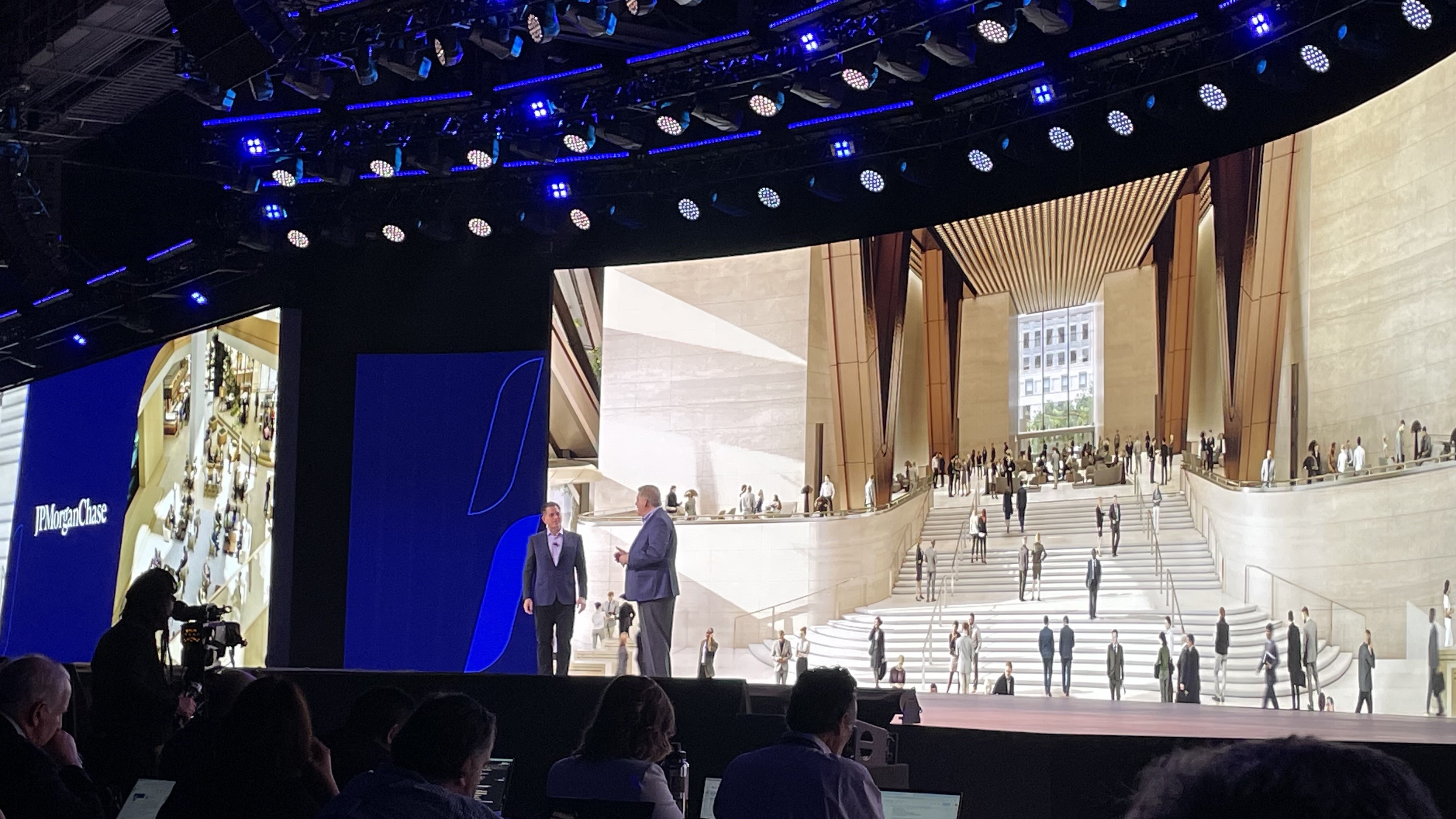
(Image credit: Future)
“We firmly believe that technology is a differentiator and the heartbeat at everything we do at JPMorgan Chase,” Feinsmith says. “In terms of our priorities, four key priorities, the first is to build best in class digital experience for our clients, customers, employees, many of the 44,000 software engineers, and for these experiences, as [Michael Dell] said, we want to leverage that exit by the data and put AI into everything we do.” This includes cybersecurity, private cloud, and LLMs.
“These are specialized deployments requiring high value engineering, custom designs, all delivered at unprecedented speed. Here’s an example of what we’re deploying right now. It’s 110,000 GPUs, the electric, direct, liquid cool,” he says. “It uses 240 megawatts of power. It’s 27,500 GPU nodes, 2800 racks, 6000 network switches, 27,000 miles of network cables. That’s enough to wrap around the earth and then some six miles of water pipes and 77 miles of rubber hose to circulate the 100,000 gallons of water needed to recirculate throughout the system”
Not everyone needs such specialised infrastructure, he says, “but you do need AI”. This, he says can take the form of AI PCs or “small, domain-specific models running on the edge”.
“We’re creating a future where intelligence amplifies human potential on a massive scale,” says Dell. “Standing on the corner of Dell Technologies way and a new age of the world’s most advanced intelligence factories are right here, from … AIS Colossus to core weave, ServiceNow, Mistral and many others.”
Michael Dell, CEO and founder is now on stage on “Dell Technologies Way” where the future is built, he says, talking about the future of business and AI.
“You know, at Dell, we love Data,” he says. And AI is the future of data, business and our lives, he claims.
Lights down, roll VT we are off! A montage of factories, F1 cars, call centers and electricity pylons gives an idea of some of the topics that might be up for discussion this morning
There’s only about 30 minutes now until the opening keynote and the auditorium at the Venetian Conference & Expo Center is starting to fill up with delegates, who are taking their seats to the sound of ‘Poprocks’, our house band for the morning.

(Image credit: Jane McCallion/Future)
With only a couple of hours to go until the keynote gets underway, the Venetian Conference & Expo Center is buzzing with activity. I’ve so far heard speculation about a change in incentives for partners, while some of the images on the Las Vegas Sphere last night seem to hint at announcements to do with laptops and PowerStore.
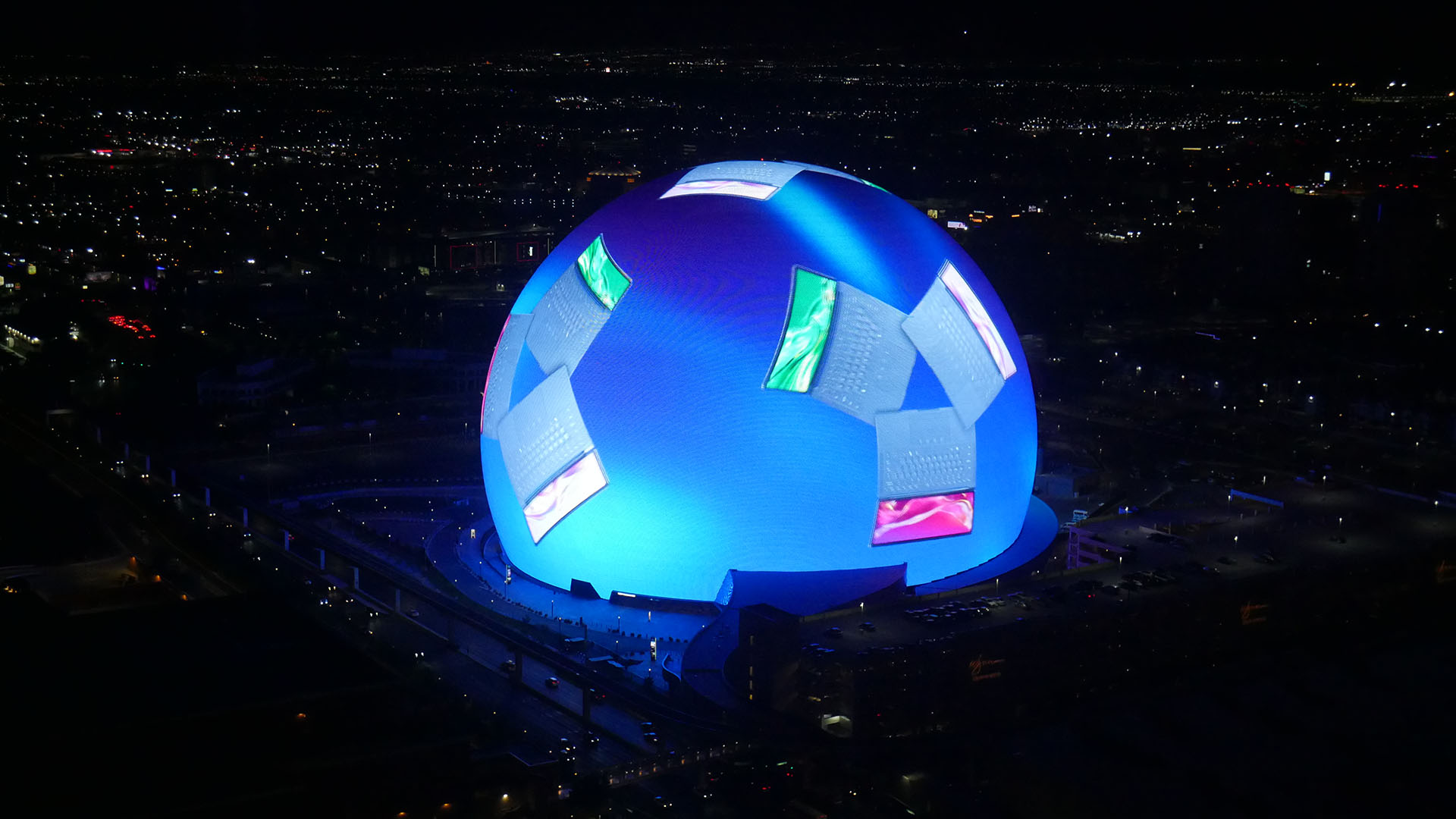
(Image credit: Jane McCallion/Future)

(Image credit: Jane McCallion/Future)
Source link





